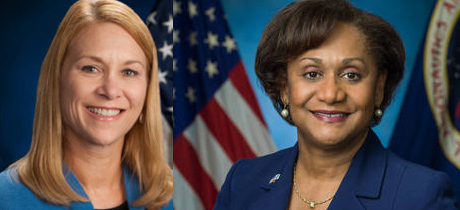In Today’s Deep Space Extra… NASA names two women to lead the Kennedy Space Center and the Johnson Space Center.
Human Space Exploration
Two NASA Centers get new Directors, both women
Spacepolicyonline.com (6/30): Vanessa Wyche was named director of the Johnson Space Center (JSC) by NASA Administrator Bill Nelson on Wednesday. Wyche has been serving in an acting role since May, taking over for Mark Geyer, who retired. A bioengineer, Wyche is a 31-year NASA veteran. Janet Petro was also named director of NASA’s Kennedy Space Center (KSC) on Wednesday. Petro is the first woman to lead (KSC) in its almost 60-year history. She was Bob Cabana’s deputy before he moved up to NASA Headquarters last month to serve as Associate Administrator, the top civil servant in the agency.
Space Science
Mars has auroras and a U.A.E. spacecraft captured new pictures of them
Nation World News (6/30): The United Arab Emirates (UAE) Hope orbiter, which reached Mars in February, is characterizing an auroral display in the planet’s atmosphere with a far bigger reach than the Earth’s aurora, which are centered above the south and north poles. Ongoing studies may reveal new details about the thin Martian atmosphere.
World’s largest radio telescope to be built after almost 30 years of planning
Space.com (6/30): Construction is set to begin July 1 on the world’s largest radio telescope, the Square Kilometer Array Observatory, at sites in Australia and South Africa. The start comes after three decades of preparations. The array will be able to detect objects so distant their radio waves take 13 billion years to reach Earth.
Other News
China outlines space plans to 2025
SpaceNews.com (6/30): China’s major projects for the 2021-2025 period focus on lunar, interplanetary and near-Earth asteroid missions, space station construction, a national satellite internet project, and developing heavy-lift and reusable space transportation systems. The country is also looking to build on the recent Tianwen-1 Mars orbiter and Zhurong rover missions by developing a Mars sample return project and a Jupiter probe for launches around 2028 and 2030 respectively. Expanding international cooperation is another major goal.
Japan eyes “Asia’s hub in space business” with more spaceports
SpaceNews.com (6/30): Japan says it will build more spaceports to make the country “Asia’s hub in space business.” Other initiatives include the development of small satellite constellations through public-private collaboration, space-based solar power, and future space transportation systems. The goals were revealed during a June 18 economic growth strategy meeting hosted by Prime Minister Yoshihide Suga. A post-meeting document shows how serious Japan is in space development, describing space as critical for the country’s economic growth, national security and disaster management, and putting it side by side with other fields such as artificial intelligence, supercomputers, quantum technology, nuclear power, and biotechnologies.
Russia says SpaceX Starlink satellite and space junk may narrowly miss Progress cargo ship in orbit
Space.com (6/30): Russia’s space agency cautioned Wednesday that the Progress MS-17 resupply mission capsule, also designated Progress 78, that launched to the International Space Station (ISS) late Tuesday will be closely approached by a SpaceX Starlink small internet connectivity satellite as well as a Falcon 9 rocket fragment. The Progress capsule is on course to dock with the ISS’s Russian segment on Thursday at 9:03 p.m. EDT.
NASA makes more than 800 innovations available to public
ZD Net (6/30): NASA is sharing software innovations through its Technology Transfer program, which is run by the Space Technology Mission Directorate. The agency noted that it was important for American taxpayers to benefit from technologies developed by and for NASA. There will be a virtual event on July 13 to explain the effort and answer questions.

